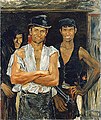Ernst Josephson: Difference between revisions
Extended confirmed users 549 edits No edit summary |
Rescuing 1 sources and tagging 0 as dead. #IABot (v1.6.1) (Balon Greyjoy) |
||
| Line 46: | Line 46: | ||
* {{cite encyclopedia | encyclopedia=Ett Binds Leksikon | edition=3 | year=1990 | article=Josephson, Ernst}} |
* {{cite encyclopedia | encyclopedia=Ett Binds Leksikon | edition=3 | year=1990 | article=Josephson, Ernst}} |
||
* [[:sv:Ernst Josephson|Ernst Josephson]] from the Swedish-language Wikipedia. Retrieved 4 July 2005. |
* [[:sv:Ernst Josephson|Ernst Josephson]] from the Swedish-language Wikipedia. Retrieved 4 July 2005. |
||
*[http://www.waldemarsudde.se/ernst_josephson_e.html Waldemarsudde Museum] |
*[https://archive.is/20061007115652/http://www.waldemarsudde.se/ernst_josephson_e.html Waldemarsudde Museum] |
||
{{Authority control}} |
{{Authority control}} |
||
Revision as of 07:56, 6 January 2018
Ernst Josephson | |
|---|---|
Royal Swedish Academy of Arts, Stockholm | |
| Known for | Painting |
Ernst Josephson (16 April 1851,
He did his art studies in Italy, France and the Netherlands, among others, and is reputed to have said at the age of 20: "I will become Sweden's Rembrandt or die."
However, his life was marred by illness. He contracted
He was later taken to hospital in Uppsala and diagnosed with schizophrenia, but continued working throughout his disease, often while in a trance-like state.
He also wrote poetry, in the collections Svarta rosor (1888, Black Roses) and Gula rosor (1896, Yellow Roses). His main work, Näcken (1884, the
Josephson's painting "Strömkarlen" shows the strong influence he has had on the current crop of Scandinavian figurative painters, most notably the Norwegian Odd Nerdrum.
Actor Erland Josephson is his grandson.
Gallery
-
David and Saul, (1878).
-
Spanish blacksmiths, (1881).
-
Näcken, (1882).
-
Portrait of Jeanette Rubenson, (1883).
-
Gåslisa, (1888–1890).
-
Smile, (1890).
References
- Facos, Michelle, “A Controversy in Late Nineteenth Century Swedish Painting: Ernst Josephson’s The Water Sprite,” Zeitschrift für Kunstgeschichte (Fall 1993) vol. 56, no. 1: 61-78
- Facos, Michelle, Nationalism and the Nordic Imagination. Swedish Art of the 1890s. University of California Press (1998)
- "Josephson, Ernst". Ett Binds Leksikon (3 ed.). 1990.
- Ernst Josephson from the Swedish-language Wikipedia. Retrieved 4 July 2005.
- Waldemarsudde Museum






